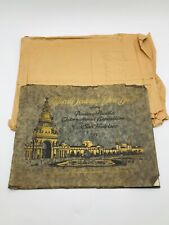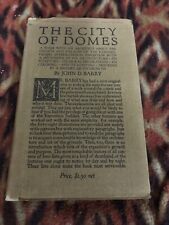When you click on links to various merchants on this site and make a purchase, this can result in this site earning a commission. Affiliate programs and affiliations include, but are not limited to, the eBay Partner Network.
HERE’S a RARE and VINTAGE 1915 PANAMAEXPOSITION INTERNATIONAL EXPOSITION, SAN FRANCISCO/SAN DIEGO EXPOSITION OFFICIALCOMMEMORATIVE VIEW BOOK!
Theexposition is most remembered because of the completion of the Panama Canal in1915!!!!
A RAREPIECE OF AMERICAN EXPO HISTORY!
VERY GOOD, CLEAN CONDITION - measures 10 1/2\" x 7\"!
<<: BRIEF HISTORY of the Panama- Pacific International Exposition :>>
The Panama–Pacific International Exposition (PPIE) was a world\'s fair held in San Francisco, in the United States,between February 20 and December 4 in 1915. Its ostensible purpose was tocelebrate the completion of the Panama Canal, but it was widely seen inthe city as an opportunity to showcase its recovery from the 1906earthquake. The fair was constructed on a 635acre (2.6 km2) site in SanFrancisco, along the northern shore now known as the MarinaDistrict.
Exhibits
Among the exhibits at the Exposition was the C. P. Huntington, the first steam locomotive purchased by SouthernPacific Railroad; the locomotive is now on static display at the CaliforniaState Railroad Museum in Sacramento.A telephone line was also established to New York so people across the continentcould hear the Pacific Ocean.The Liberty Bell traveled by train on anationwide tour from Pennsylvania to attendthe exposition. After that trip, the Liberty Bell returned to Philadelphia, and has not made any furtherjourneys since.[1]
The 1915American Grand Prize and Vanderbilt Cup auto races were heldFebruary 27 and March 6 on a 3.84-mile (6.18km) circuit set up around theExposition grounds.[2] The SmithsonianInstitution also had an exhibition at the Exposition.[3]
Architecture
The centerpiece was the Tower of Jewels,which rose to 435 feet and was covered with over 100,000 cut glass Novagems.The 3⁄4 to 2 inch colored\"gems\" sparkled in sunlight throughout the day and were illuminatedby over 50 powerful electrical searchlights at night.
In front of the Tower, the Fountain of Energy flowed at the center of theSouth Gardens, flanked by the Palace of Horticulture on the west and theFestival Hall to the east. The arch of the Tower served as the gateway to theCourt of the Universe, leading to the Court of the Four Seasons to the west andthe Court of Abundance to the east. These courts formed the primary exhibitarea for the fair, which included the Food Products Palace, the Education andSocial Economy Palace, the Agriculture Palace, the Liberal Arts Palace, theTransportation Palace, the Manufacturers Palace, the Mines and MetallurgyPalace, and the Varied Industries Palace. The Machinery Palace, the largesthall, dominated the east end of the central court.
At the west end of central court group was the Palace of FineArts. Further west toward the bay down The Avenue of the Nationswere national and states\' buildings, displaying customs and products unique tothe area represented. At the opposite end of the Fair, near Fort Mason was \"The Zone\", anavenue of popular amusements and concessions stands.
Construction
Constructed from temporary materials (primarily staff,a combination of plaster and burlap fiber), almost all the fair\'s variousbuildings and attractions were pulled down in late 1915. Intended to fall intopieces at the close of the fair (reportedly because the architect believedevery great city needed ruins), the only surviving building on the Expositiongrounds, Bernard Maybeck\'sPalace of FineArts, remained in place, slowly falling into disrepair[4] (although the hall used todisplay painting and sculpture during the Fair was repurposed as a garage forjeeps during World War II).The Palace, including the colonnade with its signature weeping women androtunda dome, was completely reconstructed in the 1960s and a seismic retrofitwas completed in early 2009. The Exploratorium, an interactive sciencemuseum, occupied the northern 2/3 of the Palace from 1969 to 2013; thecity-owned Palace of Fine Arts Theater, has occupied the southern 1/3 since1970.
A panorama of the Palace of Fine Arts c.1919. The current building wasrebuilt in the 1930s, again in the 1960s, and then seismically retrofittedafter damage from 1989\'s Loma Prieta Earthquake, and again in 2009.
Othersurviving buildings
Buildings from the Exposition that still stand today (other than thePalace of Fine Arts) include what is now called the Bill GrahamCivic Auditorium at Civic Center Plaza and the Japanese Tea house,which was barged down the Bay to Belmont,California and currently operates as a restaurant. Also survivingare the one-third steam engines of the Overland Railroad that operated at theExposition. They are maintained in working order at the Swanton PacificRailroad Society located on Cal Poly San Luis Obispo\'s Swanton Ranch just northof Santa Cruz.
The Legion of Honor Museum, in Lincoln Park, was the gift of Alma deBretteville Spreckels, wife of the sugar magnate and thoroughbred racehorse owner/breeder Adolph B.Spreckels.[5] The building is a full-scalereplica of the French Pavilion from the 1915 Panama Pacific InternationalExposition, which in turn was a three-quarter-scale version of the Palais de laLégion d\'Honneur also known as the Hôtel de Salm in Paris by George Applegarth and H. Guillaume. At the close ofthe exposition, the French government granted Spreckels permission to constructa permanent replica of the French Pavilion, but World War I delayed thegroundbreaking until 1921. [6]
Commemorations
Postcard showing new buildings in San Francisco, with earthquake ruins andbear in foreground, and two small images of buildings of the Exposition atbottom
The US Post Office issued a set of four postage stamps to commemorate theexposition, with designs depicting a profile of Vasco Núñez deBalboa (1¢), the Pedro Miguel Locksof the Panama Canal (2¢), the Golden Gate (5¢), and the discovery of San Francisco Bay (10¢). The stamps werefirst put on sale in 1913, to promote the coming event, and perforated 12, andthen reissued in 1914 and 1915, perforated 10. Their prices today range widely;the 2¢ of 1913 is available for under a dollar in used condition, while anunused 10¢ of the scarcer orange-yellow variety in 1915 can be worth up to athousand United Statesdollars.[7]
Congress authorized the San Francisco Mint(also known as \"The Granite Lady\") to issue a series of fivecommemorative coins. Said coins were the 1915-S silver Panama-Pacific halfdollar and four gold coins. The denominations of the gold coins were $1, $21⁄2(quarter eagle) and $50 (in two types: a round coin, and an unusual octagonalcoin). The Panama-Pacific coins have the distinction of being the firstcommemorative coins to bear the motto \"In God We Trust\", and werealso the first commemoratives to be struck at a branch mint.[8] The gold coins are scarce whilethe two $50 ones are extremely rare. The half dollar had a mintage of 27,134and in modestly worn condition is available for several hundred dollars.[9]
Numismatist Farran Zerbe supervised the creation of aseries of commemorative medals, an award medal, a souvenir medal, and diplomas.
In 2015, the California Historical Society, the Maybeck Foundation, andInnovation Hangar will partner with the City and County of San Francisco tocommemorate the centennial of the transformative 1915 Panama PacificInternational Exposition.
On June 20th, 2015 a commemorative orchestra, chorus, and band concertwill be held at the Palace of Fine Arts to celebrate the 100th anniversary ofthe fair.
I am a proud member ofthe Universal Autograph Collectors Club (UACC), The Ephemera Society ofAmerica, the Manuscript Society and the American Political Items Collectors(APIC) (member name: John Lissandrello). I subscribe to each organizations\'code of ethics and authenticity is guaranteed. ~Providing quality service andhistorical memorabilia online for over ten years.~WE ONLY SELL GENUINE ITEMS, i.e., NO REPRODUCTIONS, FAKES OR COPIES!











